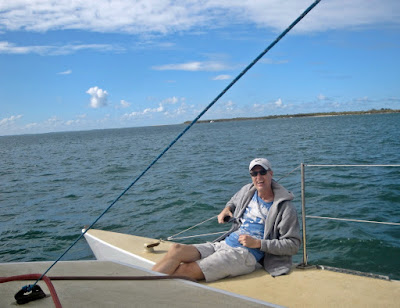It's been a while since our last blog update. We're now in Gladstone, more precisely we've anchored in the shallow and narrow Boyne River mouth a few miles south of Gladstone harbour. We left Pialba early morning on Tuesday last week and motored until out of the shallow water. The morning mist cleared and it became a beautiful sunny day. We sailed with a light wind behind us and it was most enjoyable with the sails up and the boat moving steadily along. Eight and a half hours later we sailed into the mouth of Burnett River and anchored off Port Bundaberg. We were expecting a busy river shipping channel as this is the most popular Australian destination for boats crossing the Pacific as well as a sugar loading wharf for Bundaberg's main industry. It was surprisingly quiet and peaceful and we enjoyed the comfortable anchorage, a tranquil spot that we shared with a family of pelicans and a lone fisherman.
The next day we puttered in the dinghy to Burnett Heads Marina and went ashore to stretch our legs and explore the area. We saw a group of free ranging kangaroos just hopping about at the outskirts of the village. They were a bit camera shy and hopped off as we approached within a few meters.
A source of amusement for us is the drive thru bottle stores in Australia. No need to get out of your car - fast liquor much like fast food, place your order, collect and pay, and drive off. Robert used the opportunity to purchase a bottle of rum for which Bundaberg is renowned. I think Bundaberg Rum is an acquired taste.
The following Thursday morning was another early start for an estimated 10 hours to Round Hill Creek.
Another gorgeous sunny day with light wind - a little too light and Robert successfully put up the spinnaker.
A few boats going in the same direction were often within close sight and we enjoyed checking out the strange looking replica of a lanteen-rigged caravel of the era of Christopher Columbus.
We approached the sand barred entrance to Round Hill Creek too casually, made a basic mistake and the boat got stuck on a sandbar. It's quite a tricky entrance as you can see from what it look like from above. But still, if we had been a bit more careful we would not have got stuck. Lessons were learned!
The tide was rising rapidly and after a few horrible moments we were pulled off the sandbar by Tony and Sandy with their boat Bulletproof from 1770 Creek 2 Reef Fishing Charters. Once free, our engine started but would not engage in a gear, so Tony and Sandy towed us in and we anchored further upstream near a holiday camp site. We are very grateful to this couple who went out of their way to assist us. The next morning Robert found that the driveshaft had pulled loose and after some effort and epoxy was able to refit it. News of our mishap had spread amongst the small village and when we went to the small campsite shop, the shopkeeper said "You're the boat people who got stuck on the sandbar". Yeah, right, ha ha.
Round Hill Creek has a great holiday vibe and dozens of boats anchored about the shallow creek. The weather was sunny and the weekend visitors clearly had good fun with paddle boards and dinghys.
There are two amphibious craft who trundle about taking people across the creek and onto the sand banks. A strange sight to have the pink apparition with wheels coming past our boat and bumbling onto and over the sandbars and beaches.
The name of the town behind the beach is "Town of 1770". Cook landed here in 1770, his second landfall in Australia.
We decided to wait out a few days to allow further checks on the driveshaft and to wait for wind as we wanted to use less engine power on the first leg after Robert's repair. On Tuesday 25th we left Round Hill Creek crossing our fingers past the notorious sandbar and sailed to Pancake Creek. It was an easy sail in 10 knot following wind and took 4 hours. Pancake Creek is a scenic area with many unspoilt beaches and thick vegetation on surrounding hills.
After another early start and an uneventful day of sailing and motoring we pulled into where we are now in Gladstone.




















































